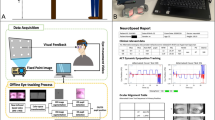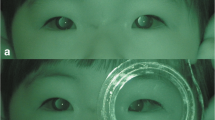Abstract
Purpose
To evaluate the usefulness of a new system using a modified Goldmann perimeter and Bagolini striated glasses for quantitative assessment of the binocular fusional field (BFF) in patients with suppression.
Methods
The BFF was assessed quantitatively in ten normal patients aged 10 to 15 years by using a modified Goldmann perimeter equipped with a xenon light source. Subjective perception was elicited with the use of a crossed or single oblique streak through Bagolini striated glasses. The BFF in 15 strabismic patients with suppression were analyzed at their initial visit and at their last visit after therapy.
Results
In normal patients, extent points of the BFF on every 15° meridian ranged from 48° to 56°. The normal BFF drawn from these average points was approximately equal to the previously published normal format of binocular single vision for strabismic patients with diplopia. Additionally, this scoring system for BFF provided quantitatively objective information during the course of their extraocular disorder in 15 strabismic patients with suppression.
Conclusion
This new method of assessing BFF in patients with suppression can be helpful for evaluation of quantitative effects in the course of treatment for an extraocular disorder and compensatory abnormal head position.
Similar content being viewed by others
References
von Noorden GK, Campos EC. Examination of the patient—III. Binocular vision and ocular motility. St Louis: Mosby; 2002. p. 211–245.
Woodruff G, O’Reilly C, Kraft SP. Functional scoring of the field of binocular single vision in patients with diplopia. Ophthalmology 1987;94:1554–1561.
Sullivan TJ, Kraft SP, Burack C, et al. A functional scoring method for the field of binocular single vision. Ophthalmology 1992;99:575–581.
White J, Hjertaas R, Johnston B. Reversible modification of the Goldmann perimeter for the assessment of the field of binocular single vision. Can J Ophthalmol 1997;32:447–449.
Ferris JD, Dawson EL, Plowman N, et al. Radiotherapy in thyroid eye disease: the effect on the field of binocular single vision. J AAPOS 2002;6:71–76.
Kouri AS, Bessant DA, Adams GG, et al. Quantitative changes in the field of binocular single vision following a faden operation to a vertical rectus muscle. J AAPOS 2002;6:294–299.
Feibel RM, Roper-Hall G. Evaluation of the field of binocular single vision in incomitant strabismus. Am J Ophthalmol 1974;78:800–805.
Roper-Hall G, Feibel RM. Measurement of the field of binocular single vision in the evaluation of incomitant paralytic strabismus. Am Orthopt J 1974;24:77–82.
Bagolini B. Tecnica per l’esame della visione binoculare senza introduzione di elementi dissocianti (test del vetro striato). Boll d’Ocul 1958;37:195.
Plager DA. Tendon laxity in superior oblique palsy. Ophthalmology 1992;99:1032–1038.
Schor CM. The relationship between fusional vergence eye movements and fixation disparity. Vis Res 1979;19:1359–1367.
von Noorden GK, Campos EC. Binocular vision and space perception. Binocular vision and ocular motility. St Louis: Mosby; 2002. p. 7–37.
Joosse MV, Simonsz HJ, de Jong PTVM. The visual field in strabismus: a historical review of studies on amblyopia and suppression. Strabismus 2000;8:135–149.
Herzau V. Untersuchungen über das binokulare Gesichtsfeld Schielender. Doc Ophthalmol 1980;49:221–284.
Campos EC. Binocularity in comitant strabismus: binocular visual fields studies. Doc Ophthalmol 1982;53:249–281.
Mehdorn E. Nasal field defects in strabismic amblyopia. Doc Ophthalmol Proc Ser 1986;45:318–328.
von Noorden GK, Campos EC. Physiology of the ocular movements. Binocular vision and ocular motility. St Louis: Mosby; 2002. p. 52–84.
Fitzsimons R, White J. Functional scoring of the field of binocular single vision. Ophthalmology 1990;97:33–35.
Yamashiro M. Objective measurement of the limit of uniocular movement. Jpn J Ophthalmol 1957;1:130–136.
Birch EE. Stereopsis and its developmental relationship to visual acuity. In: Simons H, editor. Early visual development:normal and abnormal. New York: Oxford University Press; 1993. p. 224–236.
Esterman B. Functional scoring of the binocular field. Ophthalmology 1982;89:1226–1234.
Coleman AL, Cummings SR, Yu F, et al. Binocular visual-field loss increases the risk of future falls in older white women. J Am Geriatr Soc 2007;55:357–364.
Author information
Authors and Affiliations
Corresponding author
Additional information
This paper is a re-writing of a presentation made at the 63rd Annual Meeting of the Japanese Association of Strabismus and Amblyopia, 15–16 June 2007, Nagoya, Japan
About this article
Cite this article
Yagasaki, T., Oya, Y., Maeda, M. et al. Modified method for assessment of the binocular fusional field in patients with suppression. Jpn J Ophthalmol 53, 138–144 (2009). https://doi.org/10.1007/s10384-008-0634-7
Received:
Accepted:
Published:
Issue Date:
DOI: https://doi.org/10.1007/s10384-008-0634-7




